
Aqueduct in the city of Rome – Roman aqueducts brought clean water to the people of Rome
Why did the Romans build aqueducts?
As Roman towns got bigger under the Roman Republic, it got too hard for the people who lived in the towns to get clean drinking and washing water.
Roman sewers
The Roman Republic
All Ancient Rome articles
Because raw sewage was draining into the rivers, people who drank river water often got very sick or died. They got dysentery, and it gave them diarrhea.
Read more about dysentery
When did the Romans build the first aqueduct?
Local governments, first in the city of Rome and then in other cities in the growing Empire, decided to build long stone channels to carry clean water from nearby hills to the towns. They built the first Roman aqueduct in 312 BC. People in other empires – in the Persian Empire – had been building aqueducts earlier. Persian ones had mostly run underground, and the Roman aqueducts ran partly above ground (and partly underground).
More about the Persians
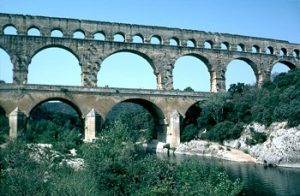
The Pont du Gard aqueduct at Nimes, in southern France (built in the first century AD)
Why do we call them aqueducts?
Aqueducts (ACK-wa-ducts) got their name from the Latin word for water, aqua, and the Latin word for channel, ductus.
By the time of the Empire, three hundred years later, most Roman towns had at least one aqueduct to bring in fresh water, and big cities like Rome had ten aqueducts or more.

The Roman aqueduct at Segovia, in eastern Spain (about 100 AD)
Aqueducts and engineering
These aqueducts were quite a challenge to build. The engineering had to be just right in order to get the water to run through the channels and get to the city without stagnating in the channel or coming too fast into the city.
The engineers had to keep the slope the same all the time, so sometimes the aqueducts had to run on high arches, and other times along the ground in stone channels, or even under the ground in tunnels.
The engineers had to use some pretty advanced geometry and measuring in order to make the aqueducts come out right. Some Roman aqueducts, like the Pont du Gard, go down only one centimeter for every 18,000 centimeters they travel horizontally. You have to measure very carefully to get such an exact slope.
Roman engineers built aqueducts all over the Roman Empire, from Syria to England. All Roman towns pretty much got clean drinking water from these aqueducts.
What if the water ran short?

The castellum divisorium at Pompeii – an automatic way of using gravity to make sure water went where it was needed.
If there was a drought and there was not enough water in the aqueduct for everybody, the Romans had a clever device that used gravity to decide who should get the water.
Roman aqueduct water flowed into a large tank. Near the bottom of the tank were holes leading to pipes. Those pipes connected to public water fountains. They could get water even if the water in the tank was very low.
Half-way up the tank were holes leading to different pipes. Those pipes led to the public baths. They only got water when the tank was half full.
Near the top of the tank were holes leading to a third set of pipes. Those led to rich people’s private houses, and to private businesses. They only got water when the tank was all the way full. That way, ordinary people could always be sure of getting water.
A famous aqueduct – the Pont du Gard
The Pont du Gard is a famous Roman aqueduct. It’s in the south of France, near the city of Nimes. “Pont” means “bridge” in French, but the Pont du Gard isn’t a bridge for people – it’s a bridge for water! It brings water from the mountains over the Gardon river to Nimes. Because the land was very uneven, the bridge had to be very high. Roman engineers built the Pont du Gard out of limestone blocks in the first century AD.
What is limestone?
Another famous aqueduct – Segovia
Not long after the Pont du Gard, about 100 AD, Roman engineers built a second huge aqueduct in eastern Spain, along the Mediterranean coast at Segovia. The Segovia aqueduct is also very high. It’s made entirely of granite blocks without mortar. The Segovia aqueduct carried water 17 kilometers (more than ten miles) from the mountains to the city of Segovia.
What is granite?

In Ostia, after the aqueducts broke down, people dug wells for water right in the middle of the street.
What about in the country? Did people have aqueducts there?
No – in villages, where most Roman people lived, there were no aqueducts. People who lived in the country often drank dirty water from the nearest river.
What is dysentery?
Women in the Roman Empire
Many women and children spent hours every day carrying water from the river or the nearest well in clay pots. Often these people got sick with dysentery from germs in their water, because their drinking water mixed with their sewage.
Did Roman aqueducts keep people from getting sick?
It’s not clear that the aqueducts really helped, because there were just as many lice and tapeworms and other parasites in places with Roman aqueducts and sewers and baths as there were in places outside the Roman empire.
What are tapeworms?
The aqueducts might have helped with germs though. Certainly they made sure there was always plenty of water to drink.
Do Roman aqueducts still work today?
People in the Roman Empire kept on using aqueducts until the 400s AD, when the fall of the Roman Empire in Western Europe meant that most towns became much smaller, and were able to get enough water from wells.
Ostia
By the 400s AD in the Roman town of Ostia, the town had gotten so much smaller that the people living there didn’t need to keep this street clear anymore, and they put their well right in the middle of the street!
The Pont du Gard
Even though it’s so high, the Pont du Gard aqueduct in France was well built and lasted very well. It carried water for 400 years, until the 500s AD. After the fall of Rome, people stopped cleaning it and it got clogged up. After that, people used the Pont du Gard as a bridge for people to cross the river.
Segovia
The Segovia aqueduct kept working much longer. First the Visigoths, then the Islamic caliphs, then the Spanish kings and queens kept it clean and repaired. King Ferdinand and Queen Isabella had it repaired. So the Segovia aqueduct still carried water into Segovia until the middle of the 1800s AD.
Aqua Virgo in Rome

The Trevi Fountain in Rome, with water from the old Roman Aqua Virgo
There are parts of Roman aqueducts still being used today. Some of the water that goes to the Trevi Fountain in Rome flows through parts of the old Aqua Virgo, a Roman aqueduct from the last century BC that ran mainly underground.
Need a second source? Check out this National Geographic article!
Did you find out what you wanted to know about Roman aqueducts? Still have questions? Ask them in the comments!
Learn by doing: build a Lego or Minecraft aqueduct that slopes slowly down and carries water. Or try carrying a full bucket of water across your yard.
Roman sewers
More about Roman science and engineering
Bibliography and further reading about Roman aqueducts:
Or read this article about how the aqueducts and sewers may not have really helped

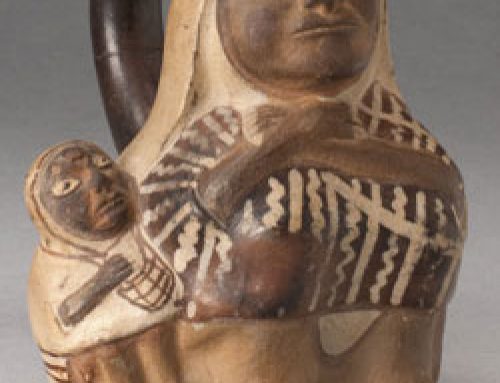
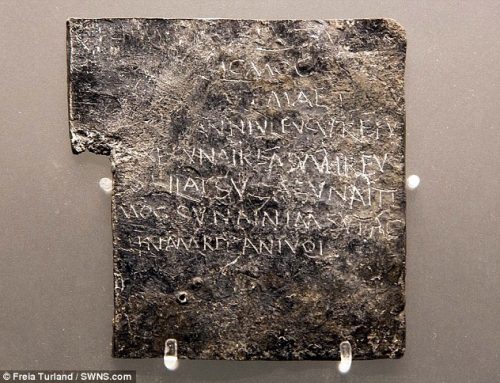
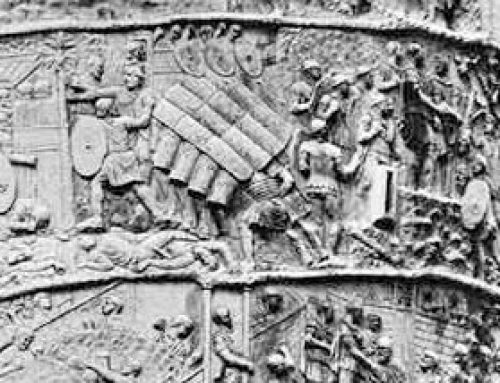
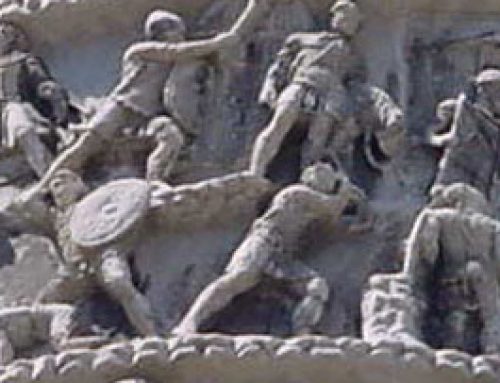
Also, thank you for the great information! Lots of my classmates use it! I’m very proud of it! Great website! Karen, i love this information!!!!!!!!!!! ????
I can use this information for a school project. Thank You! ?
This doesn’t anwer any of me questions
If you ask your questions here, I’ll try to answer them!
yo karen
im bored
all of my class mates use this site karen
This was a great website!
Hi Breon, thanks for stopping by! If anyone at your school has a page you could link to us from, that would help us out a lot, so more students could use this site. Or, if you or your folks would like to sponsor our Patreon, it’s here: https://www.patreon.com/quatr_us. Every sponsored $1.00 gets the ads off an article so we can all enjoy reading without the distracting ads.
This was a great web site
Thank you, Maricela! I love getting comments like that! I’m glad we could help. If you have a teacher or librarian who would like to link to this site, we’d be very grateful, so other students could find it! Or, if you or your folks would like to sponsor our Patreon, it’s here: https://www.patreon.com/quatr_us. Every sponsored $1.00 gets the ads off an article so we can all enjoy reading without the distracting ads.
thank you for using are website!
THX 4 INFO PEEPS
cool
sdfffffffffffffffffffffffffffffffffffffffffffffffffffffffffffffffffffffffffajksdruiiiiweeeeeeeeeeeeeeeeeeeeeeeeeeeeeeeeeeeryryryryryryryryryryryryryaul Im in a social studies class and this didnt even give me the answer to my third question can someone tell me where the second oage is because accourding to my paper there is a second page
This article used to be split into two pages, but now it’s been combined into one article, one page. What’s the third question? Maybe I can help you answer it?
very helpful. it was rad!
Nice! It’s not every day I get to be rad!
man thx you
thank u very much this was very helpful
Can you make aqueducts in Fortnite Battle Royale?
Sorry, I have no idea! Does anyone know?
10-15-2019 Chapter 2 season 1
Hello
Do you have one on frogs
Yes, here’s our article about frogs:
https://quatr.us/biology/evolution-frogs-biology.htm
Enjoy!
This is really helping. Thank you.
Thank you
do you have one on Greek mythology?
Yes! You’ll find a whole list of Greek myths here: https://quatr.us/greeks/greek-mythology-made-easy.htm
This website really helped me. Thank you so much:3
Me to, got a 100 on my quiz that I took. I studied on this site.
This site helped me so much. Thank you. Do you have an article on wolves?
You’re welcome, Raven! Thanks for visiting! We have an article on dogs that starts with wolves, here: https://quatr.us/economy/history-dogs-wolves.htm . And here is a bronze wolf from the early days of the Roman Republic: https://quatr.us/romans/roman-art-republic-ancient-rome.htm
I just did a project and got a 100, thanks! Love the site..
Wonderful! I’m so happy for you, Elijah! (If your teacher wants to link to us from the class page, that would be extra wonderful!)
hey
hi
This was very useful for my classwork. Thank you.
I really liked this but you could add maybe a little more?
If you ask specific questions, I’ll try to answer them – I don’t think it’s a good idea to just add more random sentences!
hi thanks not alat
What other questions did you have? We can try to answer them here.
I really like this! ?
Thanks!
This is really well written in my opinion, good job!
this as so “fun” :(
Well, I think you are being sarcastic, but I love studying history for realz!
yeah thanks
thanks this helped a lot
hi
hi
Very useful and nice to see many resources to see or use and good links now that everything is updated
Thank you! I’m glad we could help.
this had great info but theres no further info wheres is the other things the people that helped
Hi, I’m not sure what you are looking for but all of our Ancient Rome articles are here: https://quatr.us/ancient-rome-italy-etruscans-fall-rome
this was very educational
This is a good website to use. It helped me do some work in my Social Studies class. Thanks!
I’m happy to hear it, Kay! Thanks for letting me know!
This would’ve been a good website but it wouldn’t let me on the second page. I am trying to do a project and for half of it this website was good but that all changed. I failed thanks to you. Thank you so much!!!
Sorry about the link issue, Ashley; I’ve fixed that now.
I am also using this for a project and I was hoping to get some dimensions on the aqueducts, but I did not find any. So, maybe in the future, you could add some of the dimensions for others. Otherwise, it is a amazing website.
The dimensions of the aqueducts would be for my physical project that I would need to have the correct slope and size otherwise it would be distorted and not be able to have the right speed of flow needed to get it right.
Thanks for the suggestion, Ross! I’ll try to put together a project page that would have the information you’d need to do the project. But the slope and width varied with each aqueduct that was built, depending on how far it had to go, what the water pressure was at the source, and the topography in between.
this had a lot of great information. I am using this to help with a school project thank you :-)
Oh, I’m so happy to hear it, Hannah! Best of luck with your project. Feel free to ask if you have any questions.